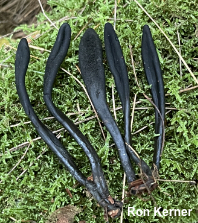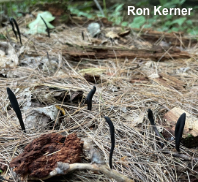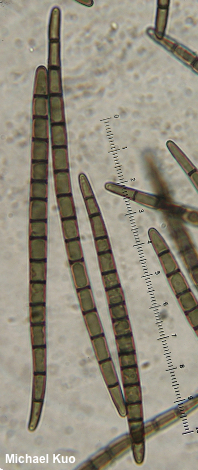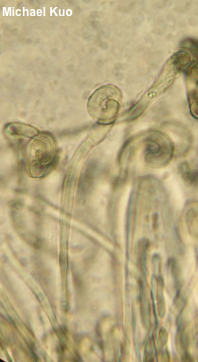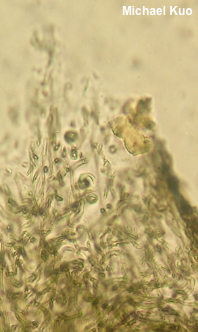| Major Groups > Clubs & Corals > Geoglossum difforme |

|
Geoglossum difforme [ Ascomycota > Geoglossales > Geoglossaceae > Geoglossum ... ] by Michael Kuo Species of Geoglossum generally require microscope work to identify, and Geoglossum difforme is no exception. Look for large spores with 15 dividing lines ("septa" in Mycologese), paraphyses that twist themselves into curlicues and pigtails, and a gelatinizing layer of cauloparaphyses extending down the stem. Because of the gelatinizing cauloparaphyses, fresh specimens of Geoglossum difforme have a sticky stem surface—but this is not a reliable identification feature because 1) species of Glutinoglossum also have sticky surfaces, and 2) the stickiness is not always evident, especially with older specimens or in dry conditions. According to some authors Geoglossum peckianum is a synonym. Thanks to Ron Kerner for documenting, collecting, and preserving Geoglossum difforme for study; his collection is deposited in The Herbarium of Michael Kuo. Description: Ecology: Saprobic; growing gregariously on the ground in hardwood and conifer forests (sometimes growing on moss-covered logs); summer and fall; originally described from Sweden; widespread in northern Europe and in North America east of the Great Plains. The described and illustrated collection is from Indiana. Fruiting Body: Club-shaped, with a well defined head that is clearly separate from the stem; 4–8 cm high. Head: 4–10 mm wide; often flattened and grooved once, longitudinally; black; finely scurfy or bald; dry. Stem: 3–5 mm wide; sometimes becoming a little flattened; bald; black; sticky when fresh; basal mycelium dark gray. Flesh: Thin; black, or whitish in the center. Odor: Not distinctive. Spore Print: Dark gray. Microscopic Features: Spores 90–120 x 5–7 µm; aciculate-fusiform; smooth; 15-septate; brown in KOH, with darker septa. Asci 8-spored; 175–200 x 15–20 µm; fusiform. Paraphyses 2–4 µm wide; filiform; exceeding the asci and then curling and twisting into curlicues and pigtails. Cauloparaphyses in a gelatinized layer, 1–3 µm wide; smooth; brown-walled; apices curling. REFERENCES: E. M. Fries, 1815. (Nannfeldt, 1942; Seaver, 1951; Mains, 1954; Smith, Smith & Weber, 1981; Phillips, 1991/2005; Barron, 1999; McNeil, 2006; Hustad et al., 2013; Beug et al., 2014; Elliott & Stephenson, 2018.) Herb. Kuo 08182102. This website contains no information about the edibility or toxicity of mushrooms. |
© MushroomExpert.Com |
|
Cite this page as: Kuo, M. (2022, June). Geoglossum difforme. Retrieved from the MushroomExpert.Com Web site: http://www.mushroomexpert.com/geoglossum_difforme.html |
